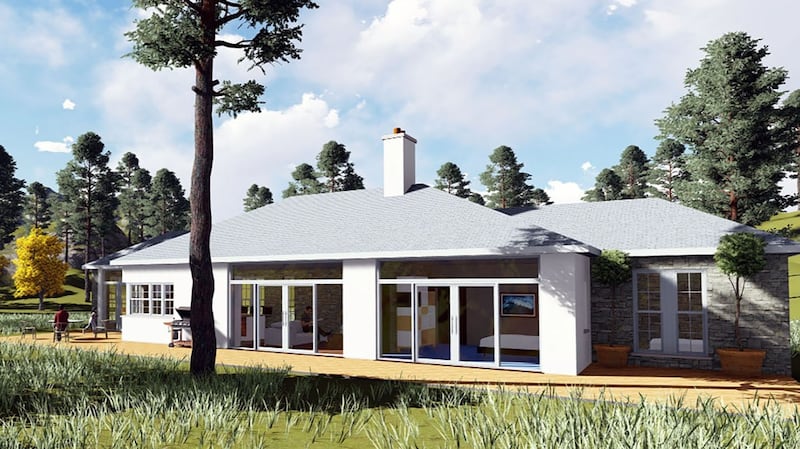Planning to renovate your home or to build a new one is one of life’s bigger decisions. The first question to ask is what professional help you are likely to need.
The stress of building can be considerable but that doesn't stop us piling into it. The economic recovery has brought on a surge of renovations and one off building projects. Between 2015 and 2016, the latest years for which figures are available, Ireland saw a 30 per cent growth in individual house builds, according to the Department of Housing, Planning and Local Government.
"Building a new home, or renovating your existing one, is an exciting time. but building is complex and requires the correct professional advice," says Kathryn Meghen, chief executive of the Royal Institute of the Architects of Ireland (RIAI). The question then is, which professional do you employ? An architect or a planning specialist can help you get planning permission, a structural engineer will advise on how to carry out work without damaging your building, and a good builder will come up with ideas and solve a multitude of problems along the way.
A registered architect has the qualifications, vision, and experience to take you expertly through your building project
Do you actually need an architect? A friend of a friend is an architectural designer and says that she can do the same job as an architect for half the price. But what’s the difference between an architectural designer and an architect? A builder says he’ll do the whole project for a fixed price. There are architectural technologists who will draw up designs that a builder can follow, project managers who will liaise with builders and suppliers and talented tradespeople who can carry out a wide range of work on site. So who should you employ? The answer is often a combination of services.
If you are going to employ an architect then it is worth remembering that “architect” is a protected title. This means that someone can only call themselves an architect if they have received the statutory training and are on the RIAI register of architects which contains a list of 2,700 individual architects and more than 600 architectural practices. They are clear: “if someone is not on the register, they are not an architect – it is as simple as that.” But isn’t it just a title?
Not according to Meghen who says that “architecture is one of the longest training among the professions in Ireland. It reflects the concern that building is both complex and an important investment on behalf of a client – as such it should be directed by a properly trained individual”. Whether you are planning to build your dream home or are extending and renovating your existing house, an RIAI “registered architect has the qualifications, vision, and experience to take you expertly through your building project”.
An architect will work “with your brief and budget and use their knowledge of planning, building regulations and health & safety requirements to develop the design for you”. They are qualified to “take the project from brief and design through the planning process and the tender process for the construction works. They advise on the engagement of the builder, manage consultants like surveyors and engineers, monitor the budget and administer the construction contract”.
For the architectural designer Joe Fallon, it boils down to a simple question: does the designer have the right skills and the right personality?
A qualified architect can provide those services but there are others who can do so too. While not everyone who provides those services can legally call themselves an architect, architectural designers like Joe Fallon have built a reputation designing and delivering high-quality residential schemes. Fallon, a self-taught architectural technologist and member of the Chartered Institute of Architectural Technologists (CIAT) runs a multi-disciplinary design practice, Joe Fallon Design. "There can often be a lot of prejudice against technologists," he says. A technologist will usually specialise in construction technology — the nuts and bolts of how a building goes together, although they often cover a much broader skill set too.
Fallon employs registered architects as well as technologists, a project manager, and engineer: His best designer? “an architectural technologist” he says, “but more often than not, one wouldn’t be better than the other”. For Fallon, it boils down to a simple question: does the designer have the right skills and the right personality?
“I need to know that if stuff goes wrong,” as it often does during a building project, “we can work through it”. Also, says Fallon, whoever you employ, regardless of their title “make sure you get references from previous clients”.
The CIAT offers similar advice. “When choosing a designer for your project, your selection method should be based on competence from an array of professionals who are all qualified to carry out the services you require. Decisions should not be based on titles.”
Cost is an important factor. "There will always be cheaper options," says Alan Jones, Belfast based architect and the next president of the Royal Institute of British Architects. The cost of who you employ will depend on the complexity of the project. The price will also vary depending on what services you require. "To do their work effectively," says Jones, an architect will "ask for a reasonable fee, which is repaid many times over in the value that is brought to your project and your life". Employ the right technologist or architectural designer and the same can also be true, as the client references on Fallon's website demonstrate.
While the titles “architect” or “chartered technologist” are important — they both give you the assurance that you are employing a regulated professional — what is perhaps more important than the title is making sure that whoever you employ is reputable, trustworthy and able to provide the skills worthy of the title they hold.
How much will a professional cost?
The cost of employing an architect or design professional will vary depending on a number of factors. Each is likely to propose a fee once they understand your brief and exactly how much work you want them to do.
If your brief is for a simple single-storey extension where planning permission is not required, then the fee should be less than a more complex, bespoke extension to a protected structure. If you want preliminary design sketches or you are undecided on your brief, they will likely charge an hourly rate. Most professionals will work on a fee based on a percentage of that final cost of the job.
Bear in mind that costs of renovating or extending a home have risen sharply in recent years. Quantity surveyor Patricia Power was recently quoted in this section
about the current level of costs. She suggests that if you're looking to do up your average 25-year old four bed semi-detached home and add an extension, you'll now find a budget of ¤200,000 "very tight".
You can now expect to pay “at least about €2,000 per square metre on an extension”, she says, revealing that she has some clients paying as much as €5,000.
Back in 2016 the RIAI indicated typical costs of about €1,500-€1,900 per square metre.
How a fee gets calculated will vary but architects seem to agree on one thing: the more detailed the brief, the easier it will be for whoever you employ to give you an accurate estimate of costs.

Should you buy house plans online?
Only 8 per cent of people who build their own homes use architects, writes Emma Cullinan. That's according to the architect Brian O'Brien, who has found a way of bringing good design to the other 92 per cent.
His method is a riff on Bungalow Bliss for the computer age: but it is much more than that. Buying house plans from websites has become big business – notably in the US and Canada but, says O'Brien, many sites ask too few questions and don't relate to quality of life.
"They are qualitative – asking how many bedrooms, bathrooms and floors you want – rather than finding out what type of family you are," says O'Brien, whose site, opoplan.com, obtains a precise profile of customers, how they live and whether they prefer, for instance, open-plan or defined spaces.
We take the best design from a real architect and customise it using architects' rules that we have developed based on my experience
“We build up a very good profile of the customer, then take the best design from a real architect and customise it using architects’ rules that we have developed based on my experience as an architect.”
O'Brien has worked on the design software – along with two computer developers – for three years in the architecture school at DIT funded by a grant from Enterprise Ireland. They have created people- and builder-friendly software in 3D that allows prospective housebuilders to walk around their virtual house while builders can see exactly what materials are used in each part of the building. It is also clear where elements are.
“We use BIM [building information modelling]. Previously [with CAD: computer aided design] certain lines didn’t know they were a wall or a window. Also, with our software, a wall knows it’s made of concrete, plaster and insulation.”
The system uses designs by architects, for buildings that weren't built or which were built in another location. The design can be tweaked, so if you prefer a traditional or modern look, the exterior can change. The house will work perfectly with the client's site, in terms of orientation, set-back and views, for instance.
You can either find a design yourself, through the Opoplan website, or use a builder who is signed up to Opoplan. For end-customers the designs cost about €2,000 but they are free through registered home builders (who pay a monthly subscription).
O Brien is calling for more architects to submit designs to the project (they get paid each time a design is used and each design generates about 20 solutions). They only use registered architects and the designs are vetted for variety and quality. "If people can't afford an architect, this is a good solution," says O Brien. "I have put all my years of architectural experience into this."
Opoplan.com


















